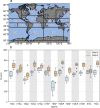An 8-model ensemble of CMIP6-derived ocean surface wave climate
- PMID: 38245553
- PMCID: PMC10799940
- DOI: 10.1038/s41597-024-02932-x
An 8-model ensemble of CMIP6-derived ocean surface wave climate
Abstract
We present a global wind wave climate model ensemble composed of eight spectral wave model simulations forced by 3-hourly surface wind speed and daily sea ice concentration from eight different CMIP6 GCMs. The spectral wave model uses ST6 physics parametrizations and a global three-grid structure for efficient Arctic and Antarctic wave modeling. The ensemble performance is evaluated against a reference global multi-mission satellite altimeter database and the recent ECMWF IFS Cy46r1 ERA5 wave hindcast, ERA5H. For each ensemble member three 30-year slices, one historical, and two future emission scenarios (SSP1-2.6 and SSP5-8.5) are available, and cover two distinct periods: 1985-2014 and 2071-2100. Two models extend to 140 years (1961-2100) of continuous wind wave climate simulations. The present ensemble outperforms a previous CMIP5-forced wind wave climate ensemble, showing improved performance across all ocean regions. This dataset is a valuable resource for future wind wave climate research and can find practical applications in offshore and coastal engineering projects, providing crucial insights into the uncertainties connected to wind wave climate future projections.
© 2024. The Author(s).
Conflict of interest statement
The authors declare no competing interests.
Figures






References
-
- Lopatoukhin, L. et al. Estimation of extreme wind wave heights. Tech. Rep., WMO (2000).
-
- Lowe, J. A. et al. Past and future changes in extreme sea levels and waves (Blackwell, 2010).
-
- Oppenheimer M, et al. Sea level rise and implications for low lying islands, coasts and communities. 2019 doi: 10.1017/9781009157964.006. - DOI
-
- Lincke D, Hinkel J, Mengel M, Nicholls RJ. Understanding the drivers of coastal flood exposure and risk from 1860 to 2100. Earth’s Future. 2022;10:e2021EF002584. doi: 10.1029/2021EF002584. - DOI
Publication types
Grants and funding
LinkOut - more resources
Full Text Sources

